After birth, caring for your infant will probably be your most important priority. Still, experts agree that you shouldn’t ignore the importance of postpartum care and postpartum recovery, especially after vaginal delivery.
In this article, our expert, Dr. Adler, OBGYN specialist, and his team discuss the importance of maternity care, what mothers can expect after vaginal delivery, and how postpartum care may help them make a faster recovery.
Vaginal Delivery and After-Birth Care
Pregnancy can change a woman’s body in several ways, and things won’t stop once the baby is born. In general, there are several things that women should expect after vaginal delivery, both emotionally and physically.
Vaginal Soreness
In the event that you experienced a vaginal tear during childbirth or your doctor performed an incision, it’s common for the wound to cause discomfort for a few weeks. In the case of more extensive tears, the healing process might require additional time. To alleviate any discomfort during your postpartum recovery:
- Sit on a padded ring or pillow.
- Use ice packs to cool the area, or use a chilled witch hazel pad that’s between a sanitary napkin and your perineum.
- With squeeze bottles, as you are passing urine, pour warm water over the perineum.
- Use OTC pain medicines. Make sure to ask your doctor about other options, such as numbing creams or sprays if necessary.
- Explore the option of using laxatives or stool softeners to prevent or combat constipation.
- Take a warm bath with water high enough to cover your hips and buttocks for at least five minutes. If it soothes more, opt for cold water.
To speed up postpartum recovery, talk to your provider if you are experiencing increasing, persistent, or severe pain.

Contractions
It’s possible to experience intermittent contractions, known as afterpains, within the initial days following childbirth. These contractions, which often feel similar to menstrual cramps, play a crucial role in reducing excessive bleeding by constricting the blood vessels in the uterus. Afterpains are frequently associated with breastfeeding, as they are triggered by the release of the hormone oxytocin. If necessary, your healthcare provider may suggest using an over-the-counter pain reliever.
Vaginal Discharge
The vagina, after giving birth, may also start to shed the membrane that was lining the uterus while you were pregnant. That said, after vaginal delivery, you may also experience discharge made up of blood and this membrane up for a few weeks. The color of the discharge will be red and might be heavy in the beginning. Slowly, as postpartum recovery progresses, it will taper down, becoming pinkish-brown and more watery.
On that note, if you are experiencing heavy bleeding after vaginal delivery, reach out to your doctor, especially if the pain is accompanied by fever, tenderness, or pelvic pain.
Skin Changes and Hair Loss
While you are pregnant, the elevated hormone levels will cause faster hair growth. This will often result in extra-lush hair, which will, after delivery, will shed. Often, hair loss in the postpartum recovery period can take up to five months.
During postpartum care, you will most probably be troubled by the visible stretch marks as well. Note that while they won’t disappear immediately after giving birth, they will eventually fade away.
Incontinence
The vagina, after birth, will go through several changes during and after pregnancy. As a matter of fact, pregnancy, labor, and delivery may injure or stretch not just the vagina but the pelvic floor muscles as well. These muscles support the rectum and bladder. If they are weak, they may cause urine incontinence and may cause leakage while laughing, sneezing, or coughing.
This is also a standard part of postpartum recovery, which will usually improve in time, but in some cases, it might become a persistent problem.
During this time, it’s advisable to use sanitary pads and engage in pelvic floor muscle exercises, commonly known as Kegels, to promote the strength and control of your pelvic floor muscles and bladder. To perform Kegels:
- Visualize as if you’re seated on a small marble and then contract your pelvic muscles as though you’re lifting that marble.
- Aim for a three-second contraction, followed by a three-second relaxation.
- Gradually progress to repeating this exercise 10 to 15 times consecutively, at least three times daily.
Changes in Mood
After-birth care will also have to address the myriad of powerful emotions women may experience after delivery. Some moms may experience the baby blues, which can be described as feeling anxious and down. The symptoms of baby blues may include crying spells, mood swings, and insomnia. Fortunately, the blues will subside in a fortnight.
On the other hand, some women may experience a more severe form of the baby blues called postpartum depression. In these cases, patients deal with more severe mood swings, fatigue, appetite loss, and loss of interest in life shortly after childbirth. In these cases, reaching out to your provider is essential, not just for ensuring your health but your infant’s as well.
Problems with Bowel Movements and Hemorrhoids
Anal swellings and pain during pooping might suggest that you have swollen veins (hemorrhoids in your anus or lower rectum. To improve postpartum care, consider:
- Using OTC hemorrhoid creams or suppositories with hydrocortisone.
- Using pads with numbing agents.
- Soaking the affected area in warm water for fifteen minutes at least two or three times daily.
Breast Tenderness
Several days after giving birth, you may encounter a condition known as engorgement, characterized by your breasts feeling full, firm, and sensitive. To prevent or alleviate engorgement, it’s recommended to breastfeed frequently from both breasts.
In cases where your breasts, including the darker areolas around the nipples, become engorged, your baby may find it challenging to latch. To facilitate a better latch, you can manually express a small amount of breast milk or use a breast pump before each feeding. To ease any discomfort in your breasts, applying warm washcloths or taking a warm shower before breastfeeding or expressing yourself can make milk removal more manageable. Between feeding sessions, the use of cold washcloths on your breasts can provide relief. Additionally, over-the-counter pain relievers may be beneficial.
If you have chosen not to breastfeed, it’s advisable to wear a supportive bra, such as a sports bra. Avoid pumping your breasts or expressing milk, as this can stimulate further milk production.

Embrace Maternity Care and Postpartum Checkups
Experts agree that postpartum care shouldn’t be a single visit following delivery but an ongoing process. That said, ensure to reach out to your provider within three weeks following delivery and visit your provider for a comprehensive evaluation 12 weeks after giving birth.
On that note, you can always consider contacting our practice. Our experts understand the importance of postpartum care and will help you assess your emotional well-being and overall mood. Additionally, apart from the essential physical examinations, you will also have the option of discussing birth spacing and contraception options with us.
We understand that you need to make adjustments to your new life and your baby, and we are ready to help you.


